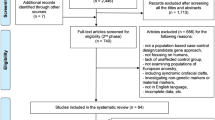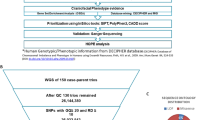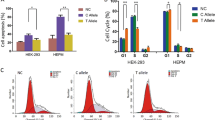Abstract
Case-parent trios were used in a genome-wide association study of cleft lip with and without cleft palate. SNPs near two genes not previously associated with cleft lip with and without cleft palate (MAFB, most significant SNP rs13041247, with odds ratio (OR) per minor allele = 0.704, 95% CI 0.635–0.778, P = 1.44 × 10−11; and ABCA4, most significant SNP rs560426, with OR = 1.432, 95% CI 1.292–1.587, P = 5.01 × 10−12) and two previously identified regions (at chromosome 8q24 and IRF6) attained genome-wide significance. Stratifying trios into European and Asian ancestry groups revealed differences in statistical significance, although estimated effect sizes remained similar. Replication studies from several populations showed confirming evidence, with families of European ancestry giving stronger evidence for markers in 8q24, whereas Asian families showed stronger evidence for association with MAFB and ABCA4. Expression studies support a role for MAFB in palatal development.
This is a preview of subscription content, access via your institution
Access options
Subscribe to this journal
Receive 12 print issues and online access
$209.00 per year
only $17.42 per issue
Buy this article
- Purchase on Springer Link
- Instant access to full article PDF
Prices may be subject to local taxes which are calculated during checkout




Similar content being viewed by others
Change history
12 July 2010
In the version of this article initially published, the author John M. Scott (Trinity College, Dublin) was incorrectly written as James M. Scott. The error has been corrected in the HTML and PDF versions of the article.
References
Mossey, P.A., Little, J., Munger, R.G., Dixon, M.J. & Shaw, W.C. Cleft lip and palate. Lancet 374, 1773–1785 (2009).
Jugessur, A., Farlie, P.G. & Kilpatrick, N. The genetics of isolated orofacial clefts: from genotypes to subphenotypes. Oral Dis. 15, 437–453 (2009).
Sivertsen, A., Wilcox, A.J., Skjærven, R. & Vindenes, H.A. Familial risk of oral clefts by morphological type and severity: population based cohort study of first degree relatives. Br. Med. J. 336, 432–434 (2008).
Grosen, D. et al. A cohort study of recurrence patterns among more than 54,000 relatives of oral cleft cases in Denmark: support for the multifactorial threshold model of inheritance. J. Med. Genet. 47, 162–168 (2010).
Mitchell, L.E. Twin studies in oral cleft research. in. Cleft Lip and Palate (ed. Wyszynski, D.F.) 214–221 (Oxford University Press, New York, 2002).
Zucchero, T.M. et al. Interferon regulatory factor 6 (IRF6) gene variants and the risk of isolated cleft lip or palate. N. Engl. J. Med. 351, 769–780 (2004).
Park, J.W. et al. Association between IRF6 and nonsyndromic cleft lip with or without cleft palate in four populations. Genet. Med. 9, 219–227 (2007).
Vieira, A.R., Cooper, M.E., Marazita, M.L., Orioli, I.M. & Castilla, E.E. Interferon regulatory factor 6 (IRF6) is associated with oral-facial cleft in individuals that originate in South America. Am. J. Med. Genet. A. 143A, 2075–2078 (2007).
Jugessur, A. et al. Genetic variants in IRF6 and the risk of facial clefts: single-marker and haplotype-based analyses in a population-based case-control study of facial clefts in Norway. Genet. Epidemiol. 32, 413–424 (2008).
Rahimov, F. et al. Disruption of an AP-2α site in an IRF6 enhancer is strongly associated with cleft lip. Nat. Genet. 40, 1341–1347 (2008).
Birnbaum, S. et al. Key susceptibility locus for nonsyndromic cleft lip with or without cleft palate on chromosome 8q24. Nat. Genet. 41, 473–477 (2009).
Grant, S.F.A. et al. A genome-wide association study identifies a locus for nonsyndromic cleft lip with or without cleft palate on 8q24. J. Pediatr. 155, 909–913 (2009).
Mangold, E. et al. Genome wide association study identifies two susceptibility loci for nonsyndromic cleft lip with or without cleft palate. Nat. Genet. 42, 24–26 (2010).
Laird, N.M. & Lange, C. Family based methods for linkage and association analysis. Adv. Genet. 60, 219–252 (2008).
Yang, Y. & Cvekl, A. Large Maf transcription factors: cousins of AP-1 proteins and important regulators of cellular differentiation. Einstein J. Biol. Med. 23, 2–11 (2007).
Cornelius, MC. et al. The gene, environment association studies consortium (GENEVA): maximizing the knowledge obtained from GWAS by collaboration across studies of multplie conditions. Genet. Epidemiol., published online, doi:10.1002/gepi.20492 (20 January 2010).
Patterson, N., Price, A.L. & Reich, D. Population structure and eigenanalysis. PLoS Genet. 2, e190 (2006).
Riley, B.M. et al. Impaired FGF signaling contributes to cleft lip and palate. Proc. Natl. Acad. Sci. USA 104, 4512–4517 (2007).
Purcell, S. et al. PLINK: a toolset for whole-genome association and population-based linkage analysis. Am. J. Hum. Genet. 81, 559–575 (2007).
Rabinowitz, D. & Laird, N. A unified approach to adjusting association tests for population admixture with arbitrary pedigree structure and arbitrary missing marker information. Hum. Hered. 50, 211–223 (2000).
Horvath, S., Xu, X. & Laird, N.M. The family based association test method: strategies for studying general genotype–phenotype associations. Eur. J. Hum. Genet. 9, 301–306 (2001).
Laird, N.M., Horvath, S. & Xu, X. Implementing a unified approach to family-based tests of association. Genet. Epidemiol. 19 Suppl 1, S36–S42 (2000).
Acknowledgements
We sincerely thank all of the families at each recruitment site for participating in this study, and we gratefully acknowledge the invaluable assistance of clinical, field and laboratory staff who contributed to making this work possible. We are particularly grateful to K. Durda and J. L'Heureux of the University of Iowa for assistance with samples and phenotype data; L. Henkle for technical assistance; J. Resick, C. Brandon and K. Bardi of the University of Pittsburgh for assistance with recruitment; W. Carricato, K. Deeley and J. Ruff of the University of Pittsburgh for sample handling; P. Patel and M. Rose of Johns Hopkins for assistance with data analysis; F. Cheah of the National University of Singapore for sample processing and management; M. Feldkamp and J. Carey of the Utah Birth Defects Network for assistance with recruitment and case review; and D. Pearce of the Utah State University for sample collection and processing. Funding to support data collection, genotyping and analysis came from several sources, some to individual investigators and some to the consortium itself. The consortium for GWAS genotyping and analysis was supported by the National Institute for Dental and Craniofacial Research through U01-DE-018993; the International Consortium to Identify Genes and Interactions Controlling Oral Clefts, 2007–2009. This project was part of the Gene, Environment Association Studies Consortium (GENEVA) funded by the National Human Genome Research Institute (NHGRI) to enhance communication and collaboration among investigators conducting genome-wide studies for a variety of complex diseases. Our group benefited greatly from the work and efforts of the entire consortium, especially the work by the Coordinating Center (directed by B. Weir and C. Laurie of the University of Washington) in data cleaning and preparation of these case-parent trios for submission to the Database for Genotypes and Phenotypes (dbGaP). We also acknowledge the leadership of T. Manolio of NHGRI and E. Harris of National Institute of Dental and Craniofacial Research. Genotyping services were provided by the Center for Inherited Disease Research (CIDR), funded through a federal contract from the US National Institutes of Health (NIH) to Johns Hopkins University (contract number HHSN268200782096C). Funding for individual investigators and the replication studies include: R01-DE-014581 (T.H.B.); R37-DE08559 (J.C.M. and M.L.M.), R01-DE09886 (M.L.M., L.M. and L.L.F.), R01-DE012472 (M.L.M.), R01-DE014677 (A.C.L. and M.L.M.), R01-DE016148 (M.L.M.), P50-DE016215 (J.C.M. and M.L.M.), R21-DE016930 (M.L.M., E.E.C. and A.E.C.), R01-HD390661 and R01-DE016877 (R.G.M.). JK02-AEO15291 (A.C.L.), March of Dimes Basil O'Connor award #FY 98-0718 and Research Grant #6-FY01-61 (A.C.L.); NIH R03-AR-055313 and NIH P50-DE-16215 (project #3) (M.D.), K99-DE-018441 (R.M.); and the Canadian Institutes of Health Research MT-11263 (L.L.F.). The Smile Train Foundation supported data collection in Chengdu (E.W.J. and B.S.). This research was supported in part by the Intramural Research Program of the NIH National Institute of Environmental Health Sciences (A.J.W.).
Author information
Authors and Affiliations
Contributions
T.H.B. and J.B.H. contributed to data collection for the original consortium study, data analysis and writing the manuscript. J.C.M. and M.L.M. contributed to data collection for the original consortium study and replication samples, data analysis and writing of the manuscript. R.G.M. and A.J.W. contributed to data collection for the original consortium study and to manuscript writing. I.R. and K.Y.L. contributed to data analysis and manuscript writing. T.W. and T.M. contributed to data collection, management and analysis. M.D.F. contributed to manuscript writing. R.A.R., G.R., R.T.L., E.W.J., Y.H.W.-C., P.K.C., H.W., X.Y., S.H., V.Y., S.S.C., S.H.J. and B.S. contributed to data collection for the original consortium study. H.S. and S.-C.J. contributed to data analysis. M.E.C. contributed to the analysis of replication samples. M.A.M. contributed to data collection, genotyping and laboratory studies. M.D., A.P., E.L. and S.B. contributed to laboratory studies. A.C.L. and L.M.M. contributed to collection of replication samples and laboratory studies. A.R.V., A.E.C., E.E.C., K.C., L.M., L.L.F., M.M., L.C.B., F.P., J.L.M., A.M.M., P.N.K., J.M.S., R.M. and M.A.-B. contributed to collection of replication samples. K.F.D. contributed to genotyping and manuscript writing. E.W.P. and H.L. contributed to genotyping and analysis. A.F.S. contributed to genotyping, data analysis, laboratory studies and manuscript writing.
Corresponding author
Ethics declarations
Competing interests
The authors declare no competing financial interests.
Supplementary information
Supplementary Text and Figures
Supplementary Note, Supplementary Tables 1–7 and Supplementary Figures 1–7 (PDF 3530 kb)
Rights and permissions
About this article
Cite this article
Beaty, T., Murray, J., Marazita, M. et al. A genome-wide association study of cleft lip with and without cleft palate identifies risk variants near MAFB and ABCA4. Nat Genet 42, 525–529 (2010). https://doi.org/10.1038/ng.580
Received:
Accepted:
Published:
Issue Date:
DOI: https://doi.org/10.1038/ng.580
This article is cited by
-
Genetic association and functional validation of ZFP36L2 in non-syndromic orofacial cleft subtypes
Journal of Human Genetics (2024)
-
Identification of putative regulatory single-nucleotide variants in NTN1 gene associated with NSCL/P
Journal of Human Genetics (2023)
-
Integrative analysis of transcriptome dynamics during human craniofacial development identifies candidate disease genes
Nature Communications (2023)
-
Rare variant modifier analysis identifies variants in SEC24D associated with orofacial cleft subtypes
Human Genetics (2023)
-
Using whole exome sequencing to identify susceptibility genes associated with nonsyndromic cleft lip with or without cleft palate
Molecular Genetics and Genomics (2023)



